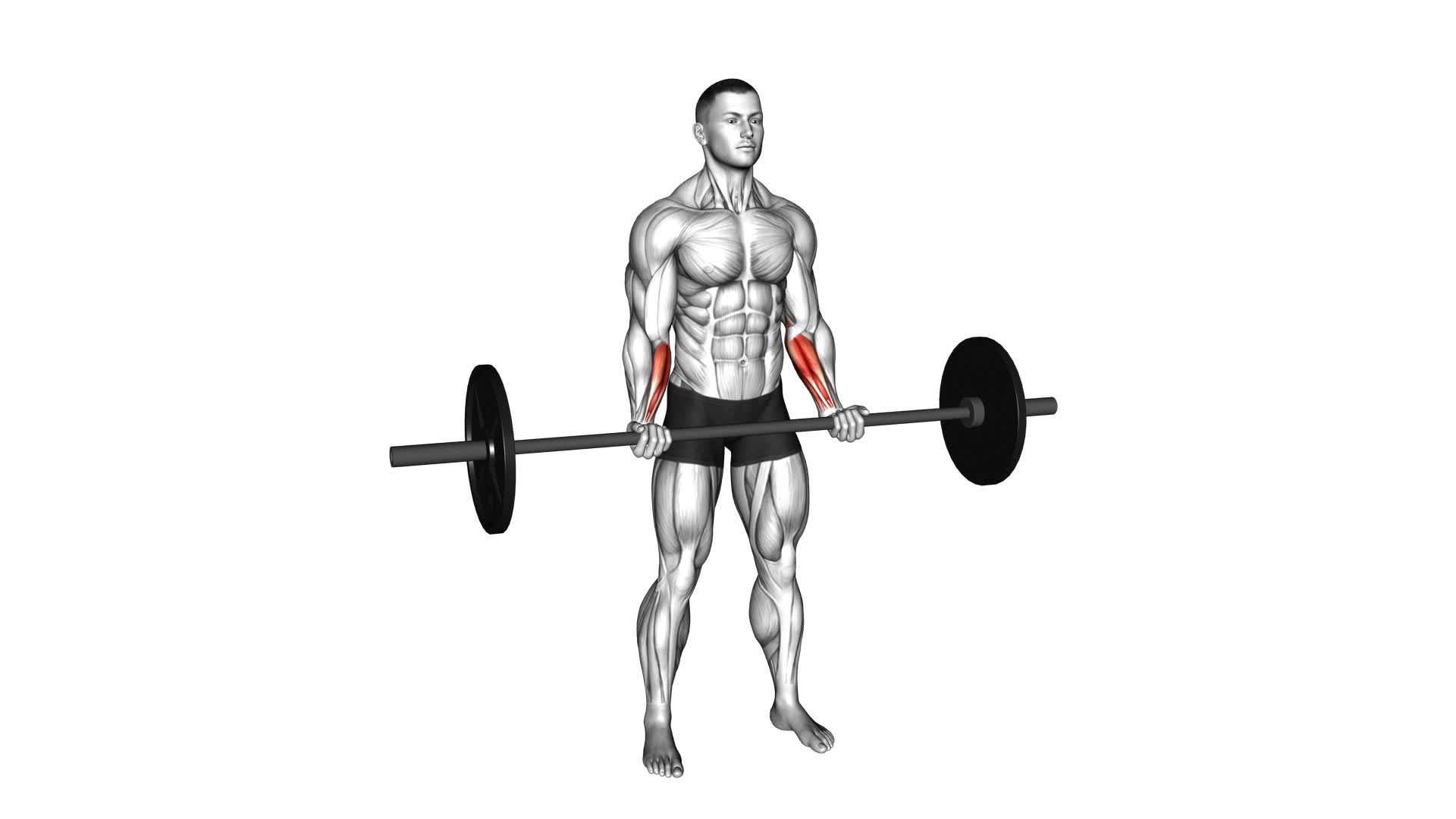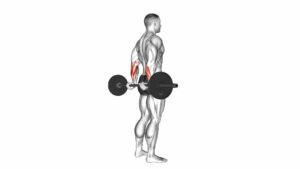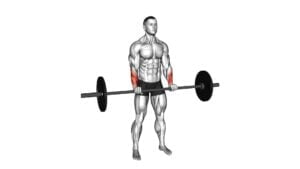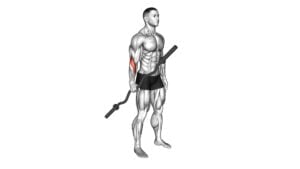Barbell Standing Wrist Curl – Video Exercise Guide & Tips

Are you looking to strengthen your wrists and increase your forearm strength? Look no further than the barbell standing wrist curl!
Watch This Exercise Video
This video exercise guide and tips will show you the proper form and technique to get the most out of this exercise.
With variations and progressions, you can challenge yourself as you improve. Avoid common mistakes and maximize your results with these expert tips.
Get ready to take your wrist strength to the next level!
Key Takeaways
- Improved forearm strength and grip
- Targets the flexor muscles responsible for bending the wrist
- Develops greater strength and endurance in the forearms
- Enhances overall strength and performance
Benefits of Barbell Standing Wrist Curl
The benefits of the barbell standing wrist curl include improved forearm strength and grip. This exercise primarily targets the forearm muscles, specifically the flexor muscles, which are responsible for bending the wrist. By performing the barbell standing wrist curl, you engage these muscles and work towards developing greater strength and endurance in your forearms.
Incorporating the barbell standing wrist curl into your workout routine is relatively simple. Start by standing with your feet shoulder-width apart and holding a barbell with an underhand grip. Rest your forearms on a flat surface, such as a bench or the top of your thighs, with your wrists hanging off the edge. Begin the exercise by curling your wrists upward, raising the barbell as high as possible, and then slowly lowering it back down to the starting position. Aim for three sets of 10-12 repetitions, gradually increasing the weight as you become stronger.
Including the barbell standing wrist curl in your training routine can benefit your overall strength and performance. Strong forearms and a solid grip are essential for various activities, such as lifting weights, playing sports, and performing daily tasks. So, give this exercise a try and enjoy the benefits of improved forearm strength and grip.
Proper Form and Technique
To perform the barbell standing wrist curl with proper form and technique, start by gripping the barbell underhand and positioning your forearms on a flat surface. This exercise is one of the most effective wrist strengthening exercises you can do. It targets the wrist flexors and extensors, helping to improve overall strength and stability in the wrists.
Proper form is crucial for maximizing the benefits of this exercise. Make sure to maintain a neutral wrist position throughout the movement and avoid excessive bending or arching. This will help prevent strain or injury to the wrists.
In addition to strength, wrist flexibility is also important for performing this exercise correctly. Adequate wrist flexibility allows for a full range of motion during the exercise, ensuring that the targeted muscles are being properly engaged.
To enhance wrist flexibility, it's recommended to incorporate stretching exercises into your routine. Wrist stretches such as wrist extensions, flexions, and rotations can help improve flexibility and reduce the risk of injury.
Equipment and Setup
For setting up the barbell standing wrist curl, position yourself in front of a flat surface with your forearms resting on it. The equipment you'll need for this exercise is a barbell and weight plates.
Using a barbell for standing wrist curls offers several benefits. Firstly, it allows you to increase the resistance and challenge your wrist flexors and extensors more effectively. The barbell also provides a more stable grip, ensuring that you can maintain proper form throughout the exercise.
To set up the barbell, start by selecting an appropriate weight based on your fitness level and goals. Load the desired weight plates onto the barbell, ensuring that they're securely fastened. Once the barbell is loaded, place it in front of you on the flat surface.
Grip the barbell with an overhand grip, with your hands shoulder-width apart. Make sure your palms are facing down. With your forearms resting on the flat surface, begin the exercise by curling your wrists upward, lifting the barbell as high as you can. Lower the barbell back down slowly and repeat for the desired number of repetitions.
Variations and Progressions
Try incorporating different weight variations and exercise progressions into your barbell standing wrist curl routine for added challenge and strength development. By incorporating variations and progressions, you can target different muscles and continue to make progress in your training.
Here are three advanced techniques to consider:
- Reverse Grip Wrist Curls: Instead of using an overhand grip, try using an underhand grip on the barbell. This variation shifts the focus onto the muscles on the underside of your forearm, providing a different stimulus for growth and strength.
- One-Arm Barbell Wrist Curls: Instead of using both hands to perform the exercise, try using just one hand at a time. This challenges your grip strength and stability, and allows you to focus more on each wrist individually.
- Increased Range of Motion: To increase the difficulty of the exercise, you can perform the barbell standing wrist curl on an elevated surface, such as a weight plate or a step. This increases the range of motion and forces your wrists to work harder to lift the weight.
Remember to always start with lighter weights and gradually increase the load as you become more comfortable with these variations and progressions. Incorporating these advanced techniques into your routine will help you continue to challenge your muscles and make progress in your wrist curl training.
Common Mistakes to Avoid
Avoid the common mistake of gripping the barbell too tightly during the standing wrist curl exercise. Many individuals make this mistake, thinking that a tighter grip will result in better strength gains. However, gripping the barbell too tightly can actually hinder your progress and limit the effectiveness of the exercise.
When performing the standing wrist curl, it's important to maintain a relaxed grip on the barbell. This allows for a full range of motion and better activation of the forearm muscles. Gripping the barbell too tightly can cause unnecessary tension in the forearms and restrict the movement, leading to suboptimal results.
Another common mistake to avoid is using excessive weight. It can be tempting to load up the barbell with heavy weights to challenge yourself, but using too much weight can compromise your form and increase the risk of injury. Start with a lighter weight and focus on proper technique before gradually increasing the resistance.
Lastly, be mindful of your wrist position throughout the exercise. It's crucial to keep your wrists straight and avoid excessive flexion or extension. Improper wrist alignment can place unnecessary stress on the joints and increase the likelihood of pain or injury. Pay attention to your form and make sure your wrists are in a neutral position throughout the movement.
Tips for Maximizing Results
To maximize your results with the barbell standing wrist curl, focus on maintaining proper form and gradually increasing the resistance. Here are three tips that can help you achieve better results:
- Nutrition tips: Fueling your body with the right nutrients is essential for muscle growth and recovery. Make sure you're consuming enough protein to support muscle repair and growth. Additionally, include a variety of fruits, vegetables, whole grains, and healthy fats in your diet to provide your body with the necessary vitamins and minerals.
- Recovery strategies: Adequate rest and recovery are crucial for allowing your muscles to repair and grow stronger. Make sure you're getting enough sleep each night, as this is when your body does most of its repair work. Additionally, consider incorporating active recovery techniques such as foam rolling, stretching, and light cardio to help reduce muscle soreness and improve blood circulation.
- Gradually increase resistance: As you become stronger and more comfortable with the exercise, gradually increase the amount of weight you're lifting. This progressive overload is important for stimulating muscle growth and preventing plateaus. However, make sure to do it in a controlled and safe manner to avoid injury.
Frequently Asked Questions
How Many Sets and Reps Should I Do for the Barbell Standing Wrist Curl Exercise?
For the barbell standing wrist curl exercise, it's important to consider how many sets and reps you should do.
The number of sets and reps can vary depending on your fitness goals and current level of strength.
It's generally recommended to start with 2-3 sets of 8-12 reps. This will help to build strength and endurance in your wrists and forearms.
As you progress, you can increase the number of sets and reps for more challenging workouts.
Can the Barbell Standing Wrist Curl Help Improve Grip Strength?
Yes, the barbell standing wrist curl can definitely help improve your grip strength. This exercise specifically targets the muscles in your forearms and wrists, which are important for a strong grip. By regularly performing barbell standing wrist curls, you can strengthen these muscles and enhance your ability to grip and hold onto objects.
Incorporating wrist exercises like this into your workout routine can have numerous benefits for your overall strength and functionality.
Is It Necessary to Use a Barbell for This Exercise, or Can Dumbbells Be Used Instead?
To answer your question, yes, it's possible to use dumbbells instead of a barbell for standing wrist curls. Using dumbbells can offer benefits such as increased range of motion and the ability to isolate each wrist individually.
Additionally, you can try variations of standing wrist curls using different equipment like resistance bands or kettlebells to target your forearms in different ways.
Remember to start with a weight that challenges you but still allows for proper form.
Can the Barbell Standing Wrist Curl Be Modified for Individuals With Wrist Injuries or Limitations?
If you have wrist injuries or limitations, there are modified variations of the barbell standing wrist curl that you can try. These variations can help you work your wrist muscles without putting too much strain on your injured or limited wrists.
Additionally, using wrist wraps can provide added support and stability during the exercise, which can further protect your wrists.
Modified variations and wrist wraps can help you safely perform the barbell standing wrist curl and reap its benefits.
Should I Perform This Exercise at the Beginning or End of My Workout?
When is the best time to perform the barbell standing wrist curl exercise, at the beginning or end of a workout?
It's important to consider your goals and priorities. If you want to prioritize wrist strength and endurance, performing this exercise at the beginning of your workout can help you focus on it while you're still fresh.
However, if you want to use the barbell standing wrist curl as a finisher for your forearm muscles, doing it at the end of your workout can be effective.
Conclusion
In conclusion, the barbell standing wrist curl is an effective exercise for strengthening and developing the muscles in your wrists. By maintaining proper form and technique, using the appropriate equipment and setup, and avoiding common mistakes, you can maximize your results and reap the benefits of this exercise.
Remember to start with lighter weights and gradually increase the intensity as your strength improves. Incorporate variations and progressions to keep challenging your muscles and continue making progress.

Author
Years ago, the spark of my life’s passion ignited in my mind the moment I stepped into the local gym for the first time. The inaugural bead of perspiration, the initial endeavor, the very first surge of endorphins, and a sense of pride that washed over me post-workout marked the beginning of my deep-seated interest in strength sports, fitness, and sports nutrition. This very curiosity blossomed rapidly into a profound fascination, propelling me to earn a Master’s degree in Physical Education from the Academy of Physical Education in Krakow, followed by a Sports Manager diploma from the Jagiellonian University. My journey of growth led me to gain more specialized qualifications, such as being a certified personal trainer with a focus on sports dietetics, a lifeguard, and an instructor for wellness and corrective gymnastics. Theoretical knowledge paired seamlessly with practical experience, reinforcing my belief that the transformation of individuals under my guidance was also a reflection of my personal growth. This belief holds true even today. Each day, I strive to push the boundaries and explore new realms. These realms gently elevate me to greater heights. The unique combination of passion for my field and the continuous quest for growth fuels my drive to break new ground.







